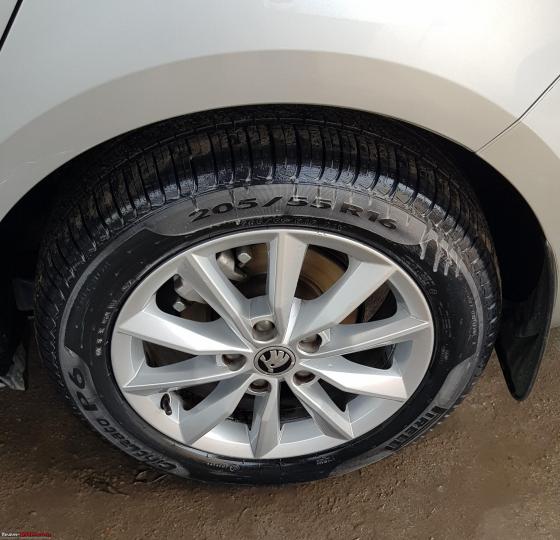News
Advice needed: Reduced fuel efficiency post tyre change
I am getting a reduced fuel efficiency figure by upto 2 km/L post tyre change.
BHPian Turbotechnixxx recently shared this with other enthusiasts.
I have a Skoda Octavia TDi AT (2019). The vehicle had come with 205/55 R16 tyres. After using the tyres for close to 43k kms I replaced them with Continental 205/60 R16 (note the difference in the ratio).
Now, I am facing a typical problem. After the replacement I was quick to observe that the on board computer was displaying a lesser mileage to a litre. Initially I thought that maybe it is because of a bigger contact patch with the road (since these are new tyres) I should get marginally lesser fuel consumption. But to my surprise I am getting a reduced average of nearly 2kmpl. I confronted the tyre seller for suggesting me to buy bigger sized tyres. He claimed that everyone goes for this upgrade and ideally there should be no deviation in average as more distance is covered per rotation by the bigger wheel.
Since I was not happy and not convinced, offered me a replacement of these tyres and gave me an option change them back to the stock size. But the question is does slightly changing the profile of the tyre cause so much deviation of around 15%? I love the overall feel with these new tyres as the ride height has increased and the bumps cannot be felt inside the cabin anymore after the change. But I am also not OK to compromise on the fuel efficiency of the vehicle by such a big margin. Please advise. Many Thanks.
Here's what BHPian tazmaan had to say on the matter:
You have upsized the tyres by 3.24 percent. Your original tyre circumference was 1985.17 mm against 2049.57 mm. In simple words when the speedometer is showing 100 kph the actual speed will be 103.24 kph and if the odometer is showing 100 kms travelled the car would have travelled 103.24 kms.
The above numbers should not make a huge difference in the average. It would be ideal to know what your milage numbers are but a reduction as per MID of 3 to 4 percent is acceptable. This is only on MID/Odometer, in reality there is no reduction.
I suggest you look elsewhere as well like due service / bad fuel / change in traffic conditions or change of driver.
Here's what BHPian Jeroen had to say on the matter:
As pointed out by taxman the change in circumference is just a few procent. Shouldn’t even show up in your fuel efficiency.
There are two other factors that can be a major contribution to your fuel efficiency:
- tire pressure
- The tire itself (make, model)
On tire pressure, just 0.2 bar higher or lower than recommended can easily give you a 10-15% difference in fuel efficiency. One problem could also be the manometer accuracy they used to pressurise your tires, see below.
There can be substantial differences in fuel efficiency (again 10-15%) between different brands/models/thread tire. Not sure about India, here in Europe tires have an efficiency rating/indication.
So it's easy to see that these two factors, either one of them, or a combination of both could cause a difference in fuel economy.
As mentioned, there are other factors that could cause the fuel efficiency to get worst. It might just have coincided with getting the tires changed.
I would at least check the tire pressure, preferably get it checked at a few different places. See if you get a different reading. Most manometers, unless they get replaced every 12 months will be wildly off.
I usually keep the pressure on all my vehicles about 0.15 and 0.20 bar higher than the normal recommended pressure. That gives me better mileage and a little higher does not really affect performance, helps actually at high speed driving on the motorway, especially with passengers and luggage in the car.
It also provides a bit of a buffer margin as tires always slowly deflate.
Make sure your tires aren’t under inflated. It will affect your fuel efficiency negatively, and also your tires are likely to wear quicker as they warm up much more.
Good luck
Jeroen
Here's what BHPian venkyhere had to say on the matter:
Contact patch size is same, if air pressure is same, section is still 205mm.
Also, 'wider' tyres usually lead to slightly more fuel consumption, and that is not because the size of the contact patch changes (area of contact patch depends only on vehicle weight and air pressure) , it is because the 'aspect ratio' of the contact patch (more rectangulary than before, if going for wider section tyres).
In your case, I can guess only three reasons :
1) something else has changed, coincidentally, independent of tyre change
2) air pressure filled in your new tyre is lower than what you had before
3) tyre compound is drastically different, your new tyres are more 'sticky' or 'grippy' - check the "TRACTION X" marking on your sidewall and compare it with old tyre. The X would be A/B/C
Here's what BHPian IshaanIan had to say on the matter:
Either your tyre pressure is too low or as Turbohead mentioned, you might be over compensating with the throttle due to the increased rotating mass on your axles (mind you, you have gone for a 10 percent increase in sidewall height ). Either way there's really no way to know what drop in fuel efficiency you're experiencing unless you do a tank-to-tank calculation; fill up to auto-stop, set trip to 0, drive about, fill up again to auto-stop, calculate mileage based on number of kms on the trip readout vs number of liters of fuel filled
Ideally you ought to have gone with stock size itself perhaps if you mention which tryes your car had, the members can recommend specific models of tyres that will give you better ride quality without having to alter your tyre size like this.
Here's what BHPian SS-Traveller had to say on the matter:
I swapped my 195/55R16s to 195/60R16s, a 3.1% circumference difference. This set off 3 calibration issues:
1. The speedometer error reduced, so while at an indicated 55 kmph I was doing 50 kmph by GPS, it now shows 52 kmph on the meter while GPS shows 50;
2. Known distances became a little shorter. What I've always known to be a 25.8 km round trip, became a 24.9 km round trip; and
3. The FE dropped from an usual tankful to tankful 18.5 kmpl on highways, to 17.2 kmpl (and the best average dropped from 21.2 kmpl to 19.3 kmpl).
So you're apparently burning more fuel per km, but you're also travelling lesser km between 2 points, which sort of evens things out! And you're riding more comfortably as an extra bonus. So why worry at all?
Read BHPian comments for more insights and information.



















